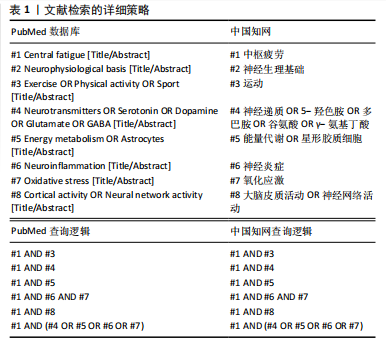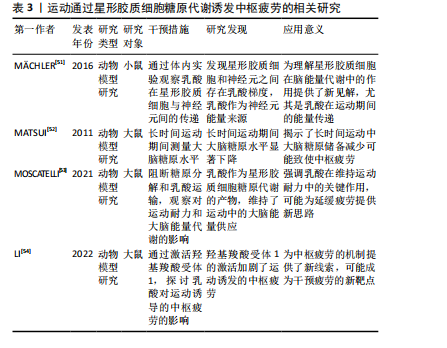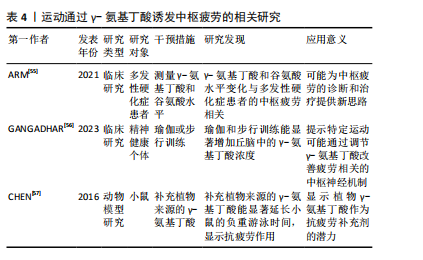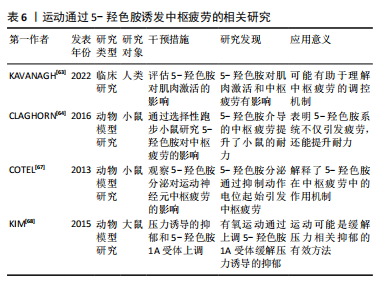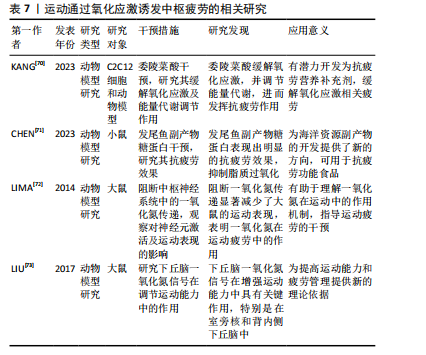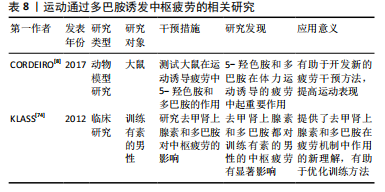[1] 田峰.对中枢与外周运动性疲劳的再认识[J].中国组织工程研究, 2015,19(42):6849-6854.
[2] RUDROFF T. Revealing the Complexity of Fatigue: A Review of the Persistent Challenges and Promises of Artificial Intelligence. Brain Sci. 2024;14(2):186.
[3] GREENHOUSE-TUCKNOTT A, BUTTERWORTH JB, WRIGHTSON JG, et al. Effect of the subjective intensity of fatigue and interoception on perceptual regulation and performance during sustained physical activity. PLoS One. 2022;17(1):e0262303.
[4] NIU H, MING D, PAPADELIS C, et al. Editorial: The Brain Under Fatigue. Front Neurosci. 2022;16:945527.
[5] ZHANG H, WANG J, GENG X, et al. Objective Assessments of Mental Fatigue During a Continuous Long-Term Stress Condition. Front Hum Neurosci. 2021;15:733426.
[6] 魏高峡,盖力锟,林萱.运动认知神经科学研究(2012~2022):10年回顾与未来展望[J].科学通报,2024,69(24):3492-3514.
[7] YANG X, LI F, LIU Y, et al. Study on the Correlation Between NF-κB and Central Fatigue. J Mol Neurosci. 2021;71(10):1975-1986.
[8] CORDEIRO LMS, RABELO PCR, MORAES MM, et al. Physical exercise-induced fatigue: the role of serotonergic and dopaminergic systems. Braz J Med Biol Res. 2017;50(12):e6432.
[9] VANTI C, ANDREATTA S, BORGHI S, et al. The effectiveness of walking versus exercise on pain and function in chronic low back pain: a systematic review and meta-analysis of randomized trials. Disabil Rehabil. 2019;41(6):622-632.
[10] KANTAMNENI S. Cross-talk and regulation between glutamate and GABAB receptors. Front Cell Neurosci. 2015;9:135.
[11] MEEUSEN R, WATSON P, HASEGAWA H, et al. Central fatigue: the serotonin hypothesis and beyond. Sports Med. 2006;36(10):881-909.
[12] SEO DY, HEO JW, KO JR, et al. Exercise and Neuroinflammation in Health and Disease. Int Neurourol J. 2019;23(Suppl 2):S82-92.
[13] MEE-INTA O, ZHAO ZW, KUO YM. Physical Exercise Inhibits Inflammation and Microglial Activation. Cells. 2019;8(7):691.
[14] KATSUHIKO S. Cytokine Response to Exercise and Its Modulation. Antioxidants. 2018;7(1):17-23.
[15] RAVI M, MILLER AH, MICHOPOULOS V. The Immunology of Stress and the Impact of Inflammation on the Brain and Behavior. BJPsych Adv. 2021;27(Suppl 3):158-165.
[16] ROELANDS B, MEEUSEN R. Alterations in central fatigue by pharmacological manipulations of neurotransmitters in normal and high ambient temperature. Sports Med. 2010;40(3):229-246.
[17] XIE Y, WU Z, SUN L, et al. The Effects and Mechanisms of Exercise on the Treatment of Depression. Front Psychiatry. 2021;12:705559.
[18] HEIJNEN S, HOMMEL B, KIBELE A, et al. Neuromodulation of Aerobic Exercise-A Review. Front Psychol. 2016;6:1890.
[19] 王若冲,吴凤芝,于清茜,等.中枢疲劳的机制研究与相关动物模型构建方法探析[J].中国医药导报,2023,20(9):181-185+197.
[20] CARLOS-LIMA E, HIGA GSV, VIANA FJC, et al. Serotonergic Modulation of the Excitation/Inhibition Balance in the Visual Cortex. Int J Mol Sci. 2023;25(1):519.
[21] ENGEL M, SMIDT MP, VAN HOOFT JA. The serotonin 5-HT3 receptor: a novel neurodevelopmental target. Front Cell Neurosci. 2013;7:76.
[22] HOEPNER CT, MCINTYRE RS, PAPAKOSTAS GI. Impact of Supplementation and Nutritional Interventions on Pathogenic Processes of Mood Disorders: A Review of the Evidence. Nutrients. 2021;13(3):767.
[23] BANWINKLER M, DZIALAS V, RIGOUX L, et al. Putaminal dopamine modulates movement motivation in Parkinson’s disease. Brain. 2024; 147(10):3352-3357.
[24] DOBRYAKOVA E, GENOVA HM, DELUCA J, et al. The dopamine imbalance hypothesis of fatigue in multiple sclerosis and other neurological disorders. Front Neurol. 2015;6:52.
[25] FOLEY TE, FLESHNER M. Neuroplasticity of dopamine circuits after exercise: implications for central fatigue. Neuromolecular Med. 2008; 10(2):67-80.
[26] 李梦民,刘滔,罗婷,等.疲劳评价与食源性抗运动疲劳成分研究进展[J].食品工业科技,2025,46(2):394-402.
[27] 高照,段锐.运动性疲劳的分子生物学机制及相关特异性基因靶点的研究进展[J].生理科学进展,2024,55(1):13-20.
[28] LI R, YANG Y, WANG H, et al. Lactate and Lactylation in the Brain: Current Progress and Perspectives. Cell Mol Neurobiol. 2023;43(6): 2541-2555.
[29] 孔健达,朱磊.长时程增强相关代谢产物的作用机制及其运动效应[J].神经解剖学杂志,2023,39(6):733-736.
[30] TORNERO-AGUILERA JF, JIMENEZ-MORCILLO J, RUBIO-ZARAPUZ A, et al. Central and Peripheral Fatigue in Physical Exercise Explained: A Narrative Review. Int J Environ Res Public Health. 2022;19(7):3909.
[31] COGGAN JS, KELLER D, CALÌ C, et al. Norepinephrine stimulates glycogenolysis in astrocytes to fuel neurons with lactate. PLoS Comput Biol. 2018;14(8):e1006392.
[32] MATSUI T, OMURO H, LIU YF, et al. Astrocytic glycogen-derived lactate fuels the brain during exhaustive exercise to maintain endurance capacity. Proc Natl Acad Sci U S A. 2017;114(24):6358-6363.
[33] BEARD E, LENGACHER S, DIAS S, et al. Astrocytes as Key Regulators of Brain Energy Metabolism: New Therapeutic Perspectives. Front Physiol. 2022;12:825816.
[34] MAGISTRETTI PJ, ALLAMAN I. Lactate in the brain: from metabolic end-product to signalling molecule. Nat Rev Neurosci. 2018;19(4):235-249.
[35] ROUMES H, PELLERIN L, BOUZIER-SORE AK. Astrocytes as metabolic suppliers to support neuronal activity and brain functions. Essays Biochem. 2023;67(1):27-37.
[36] 樊饶,孔健达,丁国诏,等.运动在延缓脑衰老中的作用:从大脑可塑性到神经保护[J].生理科学进展,2024,55(4):361-368.
[37] XUE X, LIU B, HU J, et al. The potential mechanisms of lactate in mediating exercise-enhanced cognitive function: a dual role as an energy supply substrate and a signaling molecule. Nutr Metab (Lond). 2022;19(1):52.
[38] GASMI A, PEANA M, ARSHAD M, et al. Krebs cycle: activators, inhibitors and their roles in the modulation of carcinogenesis. Arch Toxicol. 2021; 95(4):1161-1178.
[39] SHARPLES SA, GOULD JA, VANDENBERK MS, et al. Cortical Mechanisms of Central Fatigue and Sense of Effort. PLoS One. 2016;11(2):e0149026.
[40] HENDY AM, ANDRUSHKO JW, DELLA GATTA PA, et al. Acute Effects of High-Intensity Aerobic Exercise on Motor Cortical Excitability and Inhibition in Sedentary Adults. Front Psychol. 2022;13:814633.
[41] PERRIER JF, RASMUSSEN HB, JØRGENSEN LK, et al. Intense Activity of the Raphe Spinal Pathway Depresses Motor Activity via a Serotonin Dependent Mechanism. Front Neural Circuits. 2018;11:111.
[42] KONG J, FAN R, ZHANG Y, et al. Oxidative stress in the brain-lung crosstalk: cellular and molecular perspectives. Front Aging Neurosci. 2024;16:1389454.
[43] WANG M, ZHANG H, LIANG J, et al. Exercise suppresses neuroinflammation for alleviating Alzheimer’s disease. J Neuroinflammation. 2023;20(1):76.
[44] MORRIS G, BERK M, WALDER K, et al. Central pathways causing fatigue in neuro-inflammatory and autoimmune illnesses. BMC Med. 2015;13:28.
[45] HASHIMOTO T, TSUKAMOTO H, ANDO S, et al. Effect of Exercise on Brain Health: The Potential Role of Lactate as a Myokine. Metabolites. 2021;11(12):813.
[46] MAHAPATRA C, THAKKAR R, KUMAR R. Modulatory Impact of Oxidative Stress on Action Potentials in Pathophysiological States: A Comprehensive Review. Antioxidants (Basel). 2024;13(10):1172.
[47] LEE KH, CHA M, LEE BH. Neuroprotective Effect of Antioxidants in the Brain. Int J Mol Sci. 2020;21(19):7152.
[48] KAWAMURA T, MURAOKA I. Exercise-Induced Oxidative Stress and the Effects of Antioxidant Intake from a Physiological Viewpoint. Antioxidants (Basel). 2018;7(9):119.
[49] MENG Q, SU CH. The Impact of Physical Exercise on Oxidative and Nitrosative Stress: Balancing the Benefits and Risks. Antioxidants (Basel). 2024;13(5):573.
[50] YE Y, LIN H, WAN M, et al. The Effects of Aerobic Exercise on Oxidative Stress in Older Adults: A Systematic Review and Meta-Analysis. Front Physiol. 2021;12:701151.
[51] MÄCHLER P, WYSS MT, ELSAYED M, et al. In Vivo Evidence for a Lactate Gradient from Astrocytes to Neurons. Cell Metab. 2016;23(1):94-102.
[52] MATSUI T, SOYA S, OKAMOTO M, et al. Brain glycogen decreases during prolonged exercise. J Physiol. 2011;589(Pt 13):3383-3393.
[53] MOSCATELLI F, MESSINA A, VALENZANO A, et al. Transcranial Magnetic Stimulation as a Tool to Investigate Motor Cortex Excitability in Sport. Brain Sci. 2021;11(4):432.
[54] LI J, XIA Y, XU H, et al. Activation of brain lactate receptor GPR81 aggravates exercise-induced central fatigue. Am J Physiol Regul Integr Comp Physiol. 2022;323(5):R822-R831.
[55] ARM J, OELTZSCHNER G, AL-IEDANI O, et al. Altered in vivo brain GABA and glutamate levels are associated with multiple sclerosis central fatigue. Eur J Radiol. 2021;137:109610.
[56] GANGADHAR BN. Evidence-based integration of yoga in psychiatric practice. Indian J Psychiatry. 2023;65(1):5-11.
[57] CHEN H, HE X, LIU Y, et al. Extraction, purification and anti-fatigue activity of γ-aminobutyric acid from mulberry (Morus alba L.) leaves. Sci Rep. 2016;6:18933.
[58] XU Y, LIAN Y, LI J, et al. KangPiLao decoction modulates cognitive and emotional disorders in rats with central fatigue through the GABA/Glu pathway. Front Pharmacol. 2022;13:939169.
[59] ŚWIĄTKIEWICZ M, FIEDOROWICZ M, ORZEŁ J, et al. Increases in Brain 1H-MR Glutamine and Glutamate Signals Following Acute Exhaustive Endurance Exercise in the Rat. Front Physiol. 2017;8:19.
[60] COQUEIRO AY, ROGERO MM, TIRAPEGUI J. Glutamine as an Anti-Fatigue Amino Acid in Sports Nutrition. Nutrients. 2019;11(4):863.
[61] LIU W, LIU A, LI X, et al. Dual-engineered cartilage-targeting extracellular vesicles derived from mesenchymal stem cells enhance osteoarthritis treatment via miR-223/NLRP3/pyroptosis axis: Toward a precision therapy. Bioact Mater. 2023;30:169-183.
[62] GRIFKA-WALK HM, JENKINS BR, KOMINSKY DJ. Amino Acid Trp: The Far Out Impacts of Host and Commensal Tryptophan Metabolism. Front Immunol. 2021;12:653208.
[63] KAVANAGH JJ, TAYLOR JL. Voluntary activation of muscle in humans: does serotonergic neuromodulation matter? J Physiol. 2022;600(16): 3657-3670.
[64] CLAGHORN GC, FONSECA IAT, THOMPSON Z, et al. Serotonin-mediated central fatigue underlies increased endurance capacity in mice from lines selectively bred for high voluntary wheel running. Physiol Behav. 2016;161:145-154.
[65] LO MONACO M, GERVOIS P, BEAUMONT J, et al. Therapeutic Potential of Dental Pulp Stem Cells and Leukocyte- and Platelet-Rich Fibrin for Osteoarthritis. Cells. 2020;9(4):980.
[66] PEARCEY GEP, HECKMAN CJ. Serotonin affects our perception of fatigue when performing submaximal efforts - but is it all in our heads? J Physiol. 2020;598(13):2533-2534.
[67] COTEL F, EXLEY R, CRAGG SJ, et al. Serotonin spillover onto the axon initial segment of motoneurons induces central fatigue by inhibiting action potential initiation. Proc Natl Acad Sci U S A. 2013;110(12):4774-4779.
[68] KIM TW, LIM BV, BAEK D, et al. Stress-Induced Depression Is Alleviated by Aerobic Exercise Through Up-Regulation of 5-Hydroxytryptamine 1A Receptors in Rats. Int Neurourol J. 2015;19(1):27-33.
[69] FENG J, ZHENG Y, GUO M, et al. Oxidative stress, the blood-brain barrier and neurodegenerative diseases: The critical beneficial role of dietary antioxidants. Acta Pharm Sin B. 2023;13(10):3988-4024.
[70] KANG HG, LIM JH, KIM HY, et al. Anti-fatigue effect of tormentic acid through alleviating oxidative stress and energy metabolism-modulating property in C2C12 cells and animal models. Nutr Res Pract. 2023;17(4):670-681.
[71] CHEN J, LU X, CHEN P, et al. Anti-fatigue effect of glycoprotein from hairtail (Trichiurus lepturus) by-products in a behavioral mouse model. Food Chem X. 2023;18:100645.
[72] LIMA PM, SANTIAGO HP, SZAWKA RE, et al. Central blockade of nitric oxide transmission impairs exercise-induced neuronal activation in the PVN and reduces physical performance. Brain Res Bull. 2014;108:80-87.
[73] LIU H, XUE J. Involvement of hypothalamic nitric oxide signaling in the modulation of a rat’s exercise capacity. Neuroreport. 2017;28(7):408-413.
[74] KLASS M, ROELANDS B, LÉVÉNEZ M, et al. Effects of noradrenaline and dopamine on supraspinal fatigue in well-trained men. Med Sci Sports Exerc. 2012;44(12):2299-2308.
|
